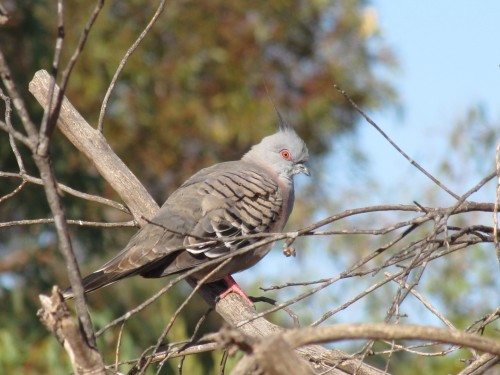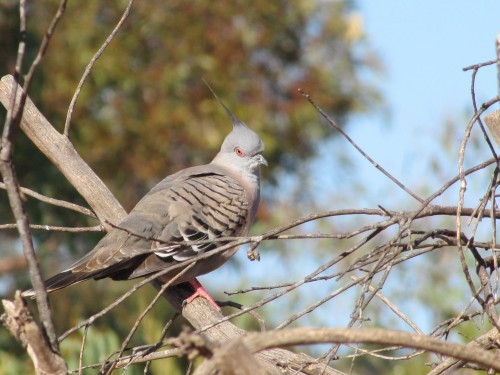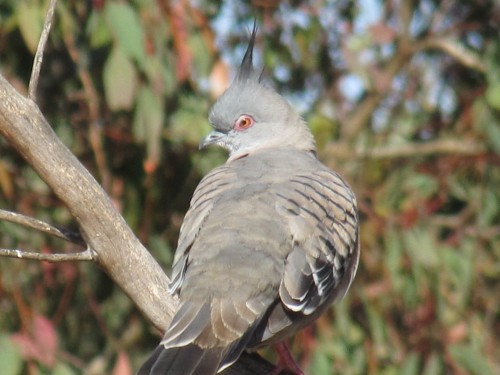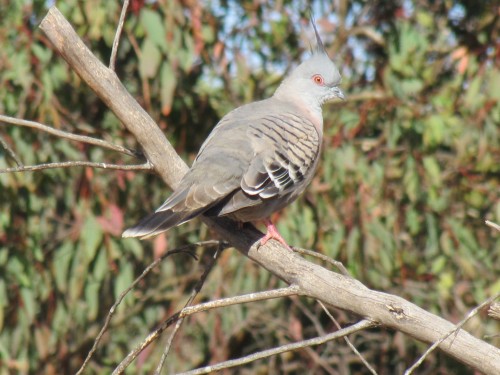Crested Pigeon in the morning sun
Earlier this week I was out in the garden taking photographs of some young Grey Currawongs being fed by their parents. After getting several good shots I went for a wander of The Estate; we live on a five acre (2 hectare) block. My attention was attracted to this Crested Pigeon perched in the sun on an exposed dead branch of a bush. (Note to self: tidy up that part of the garden and plant something alive.)
Crested Pigeons are very common around Murray Bridge. I have observed loose flocks of 20 – 50 perched on power lines in many parts of the district. They are a resident breeding species on our block of land, and seem to nest most months of the year. (Perhaps that is why they are so common.)
I must say that they are very obliging photographic subjects.
Angry birds in our garden
Last week I wrote about the young Grey Currawongs being fed by the adults in our garden. They are still hanging around and squawking noisily whenever they get hungry – which seems to be most of the time.
Yesterday morning I was doing some reading in our sun room when a sudden screeching noise outside interrupted my thoughts. I grabbed the binoculars (but not the camera, alas) and raced outside. High up in the sky above our house a Little Eagle was soaring around on the gentle breeze, obviously looking for something to eat for lunch.
The eagle seemed oblivious to the fact that both currawong parents were attacking it, screeching loudly in order to chase away the offending predator. Slowly, almost nonchalantly, the eagle glided away out of sight and the currawongs calmed down and resumed feeding the young ones., and peace resumed in the garden.
More angry birds
The currawongs are not the only angry birds resident in our garden. The Australian Magpies chase off the Grey Currawongs and the White-winged choughs, the Willie Wagtails are constantly attacking all three already mentioned and the Red Wattlebirds appear to have a distinct dislike towards anything with wings, including the hapless tiny Pardalotes. This latter conflict is a real miss-matched war: wattlebirds are bout 36cm long compared with the pardalotes weighing in at only 8cm. I reckon the wattlebirds are the big bullies in our little patch.
Baby Currawongs in the garden
I had almost finished dressing this morning when my wife called to me from the kitchen. She had just seen a bird she didn’t recognise fly onto the branch of a tree in our garden. I grabbed the camera and headed out to capture said bird on film – well, digitally, anyway.
It turned out to be a very downy young Grey Currawong waiting patiently for the parents to come feed it. Both parents were hovering in the background waiting for me to move back indoors. Later, from a distance, I saw another young bird being fed in trees a little further distance from the house.
Only a few days ago I was wondering why we hadn’t seen any currawongs in our garden recently. They must have been nesting elsewhere and busy feeding these two large babies. Nice to have them around again, though the smaller birds like the honeyeaters detest them, especially when they still have young in the nest. A baby honeyeater, pardalote or thornbill makes a tasty meal for a fast growing currawong.









